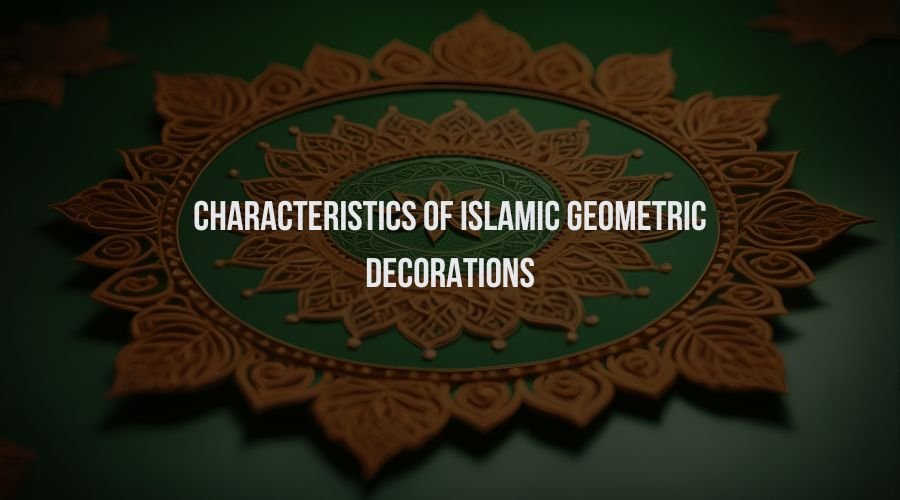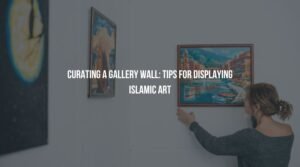Islamic art is defined by art historians as not only religious art but also art produced in a culture where Islam was a major cultural force or the dominant religion. The word “Islamic art” refers to a creative legacy that spans multiple countries and over a millennium. It comprises artwork created in the territories ruled by Islamic rulers as well as artwork influenced by Islamic religious concepts and beliefs. Islamic art varies throughout history and throughout nations, just like every other style in art history. Islamic art is defined by certain commonalities despite the wide range of artistic language and production. Islamic artists have made distinctive contributions to Islamic calligraphy, paintings, craftsmanship, and designs.
Primary Characteristics of Islamic Decor
1. The Illusion and Repetition of Infinite
The majority of patterns originate from a grid consisting of polygons like squares, hexagons, and equilateral triangles. One regular polygon is repeated to tile the plane in these grids, which are known mathematically as “regular tessellation” (derived from the Latin tesserae, i.e., pieces of mosaic). Every design, no matter how sophisticated or detailed, is based on a standard grid. The idea behind most geometric ornamentation is that any design can be duplicated and stretched forever into space. Because of this, a frame may seem random at first, serving just as a window onto a pattern that extends beyond its borders.
2. Symmetry
Islamic geometric design (Islmic wall art or Islamic art) creates symmetry by mirroring and repeating one or more fundamental design elements, most common shapes like polygons and circles. Harmony is created by the basic symmetrical repeating and mirroring of these shapes, even though the design can be expanded and made complex.
3. Two-dimensionality
Islamic geometric art is primarily two-dimensional. Not only is it typically used on flat surfaces, but there is rarely any shading or foreground-background contrast in the patterns themselves. Occasionally, though, an artist may produce overlapping or interlocking patterns that provide the impression of depth and result in a composition that is both visually appealing and playful.
4. The Emergence of Islamic Art: Tradition and Originality
The Islamic state gradually created its own creative legacy throughout its early centuries by absorbing the cultures and artistic output of the territories it subjugated. The Dome of the Rock and the Great Mosque in Damascus are two examples of early Islamic art that show how these preexisting cultures were integrated. The primary sources of Islamic artistic vocabulary were Byzantine mosaics that portrayed animals and plants, Sasanian metalwork and crafts from what is now Iraq, and Coptic scrolling vines and geometric designs from Egypt. With new forms of visual presentation, such as the decorative use of Arabic lettering and technological advancements in glass and ceramics, there was a balance struck between continuity and innovation.
5. Islamic Art and Architecture
Architecture was among the first forms of Islamic art to emerge. Islamic art produced a distinct style of religious building, not surprising given its religious foundation. Mosques, also known as masjids in Arabic, are Islamic temples that serve as gathering places for prayer, meditation, and education (madrasah).
The first mosque was the Prophet Muhammad’s home in Medina, which served as a model for later mosque construction. Although the mosque’s architecture serves a common purpose, the styles, layouts, and decorations vary depending on the time and location of construction. A frequent element of mosques is their open courtyards, or sahn, which are designed to accommodate large crowds and feature a large fountain for ceremonial washing.
6. Lack of Figural Representation in Islamic Art
Al-Mas’udi, an Arabic historian from the tenth century, writes about the earliest known mosaics found adorning an Islamic structure (Islamic Decor). Islam’s holiest site, the Kaaba, was embellished in 684 with mosaics that were most likely taken from a Byzantine church. However, the mosaics were removed not long after, in 692. Mosaics played a significant role in early Islamic history, as seen by their use on Jerusalem’s 690s Dome of the Rock. Mosaics on walls (Islamic wall art) and ceilings feature scrolls and vegetal themes together with vessels and winged crowns. The primary feature of Islamic mosaics is the lack of figural representation in religious art, as demonstrated by the Dome of the Rock. The idea that God is the only one who can create living things is the source of the opposition.
7. Sculpture in Islam: Proving Misconceptions Wrong
The sculptures that Islamic caliphs commissioned provide more evidence that the notion that Islam forbids figural representations is false. Classical mythological themes and the sculpture traditions of the ancient Greeks and Romans saw a renaissance in the eighth and ninth centuries. At least one surviving statue from the Umayyad palace at Mshatta is thought to personify a particular season as a woman bearing a piece of fruit. Among the grape leaves on the façade of Qasr al-Mshatta are carved images of griffins, peacocks, lions, and pheasants.




